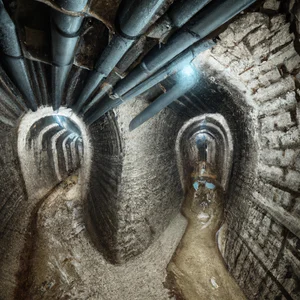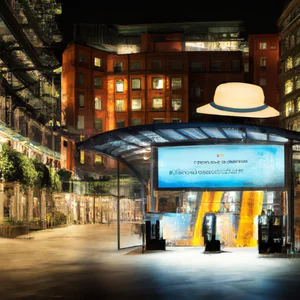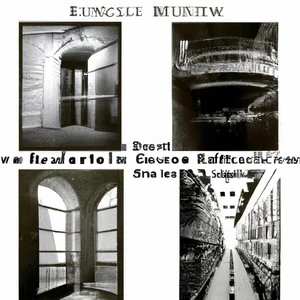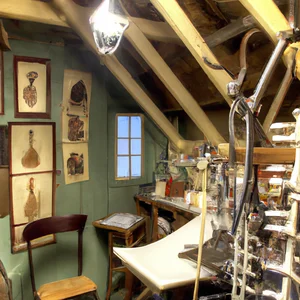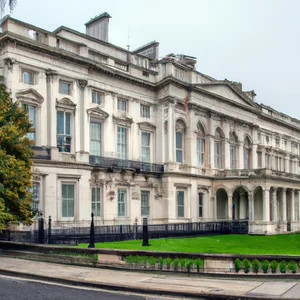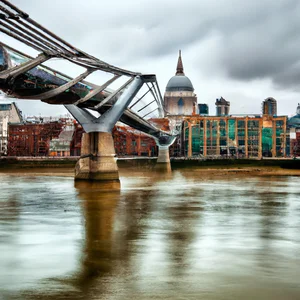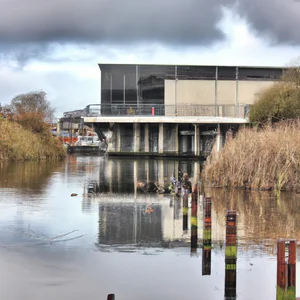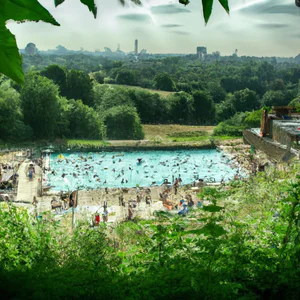Book your experience
Crossrail Place Roof Garden: Architectural oasis above the new Elizabeth Line
Ah, the Crossrail Place Roof Garden! What an incredible place! I don’t know if you’ve ever been there, but it’s like being in a corner of paradise in the middle of the frenzy of London. Imagine being there, above the new Elizabeth Line, and finding a garden that seems like something out of a dream. It’s a bit like I’ve discovered a hidden treasure, right above the city.
When I went there for the first time, I remember thinking: “Wow, you can really relax here!” It’s all green, with all kinds of plants, and there are even areas where you can sit and enjoy some tranquility. It’s strange, because while you enjoy that moment of peace, you can hear the buzz of the city that never stops. It’s a kind of contrast, almost poetic, if you think about it.
And then, oh, the views! From up there, you can basically see a lot of famous things about London. It’s like having a window into the world, although to be honest, I’m not sure I recognized everything, but that’s okay. Also because, who has time to know every corner of the city, right?
In short, if you want to take a break from everyday life, I recommend you visit this garden. It’s a bit like a refuge, a place where you can recharge your batteries. But, well, don’t expect a perfect place, there are always a few tourists around and sometimes it can be a bit crowded, but hey, it’s London! After all, it’s all part of the fun, right? So, what are you waiting for? Maybe I’ll even bring a book next time, so I can enjoy the view with a good read.
Discover the Crossrail Place Roof Garden: an urban paradise
A Personal Experience in the Greenery of London
During one of my walks through the beating heart of London, I found myself seeking refuge from the bustle of the city. And so, following the signs for the Crossrail Place Roof Garden, I discovered a corner of tranquility that almost seemed like a dream. Climbing the stairs that lead to this suspended garden, the noise of traffic and crowded voices have faded, replaced by the gentle rustling of leaves and the singing of birds. Here, among exotic plants and contemporary architecture, I breathed deeply the scent of an urban garden that tells stories of cultures and biodiversity.
Practical Information
Located above the new Elizabeth Line, the Crossrail Place Roof Garden is a must-see attraction for anyone visiting London. Open to the public all year round, the garden offers free access and is located in Canary Wharf, easily accessible by tube or DLR. Its opening hours may vary, so it is always advisable to check the official website for updates. Also, don’t forget to bring a camera; every corner is a work of art to immortalize!
Insider advice
If you want a unique experience, try to visit the garden during the week, when it is less crowded. This will allow you to fully enjoy the serene beauty of the place and find quiet corners to meditate or read a good book. Furthermore, you will have a greater chance of meeting gardeners, ready to share curiosities and anecdotes about plants with you.
Cultural and Historical Impact
The Crossrail Place Roof Garden is not only a botanical paradise, but also represents an important step towards London’s urban regeneration. This green space fits into the historic context of Canary Wharf, an area once dedicated to maritime trade. Today, the garden symbolizes the fusion of past and future, combining the modernity of the new Elizabeth Line with the natural beauty of a garden that celebrates biodiversity.
Sustainability and Responsibility
The design of the garden was created taking sustainability into account; many of the plants are native and help maintain the ecological balance of the area. It is an example of how the city can evolve, creating green spaces that not only beautify, but also support urban life. During your visit, take a moment to reflect on how important it is to preserve these corners of nature in an increasingly urbanized world.
Immersion in the Atmosphere
As you walk among the plants, let your gaze get lost in the surrounding architectural details. The winding paths, waterfalls and rest areas create a magical atmosphere that invites contemplation. You may also smell a light jasmine or lavender scent, depending on the season; a real invitation to stop and enjoy the moment.
An activity not to be missed
Don’t forget to attend one of the botanical workshops organized in the garden. These activities are not only fun, but will also give you the opportunity to learn more about plants and their care, making your visit even more memorable.
Myths to dispel
A common misconception is that the Crossrail Place Roof Garden is just a tourist attraction for photos. In fact, it is a meeting place for the local community and a center of cultural and botanical activities. Don’t be fooled by the first impression: here there is a lively and engaging energy.
Final reflection
As you leave the garden, we invite you to reflect on how places like this can exist in harmony with the frenetic pace of urban life. What is your favorite green corner in the city? And how can you help keep the beauty of nature alive in your environment?
The new Elizabeth Line: connection between past and future
A journey through time
I clearly remember the day I took the new Elizabeth Line for the first time. As the train hurtled through historic and modern tunnels, I felt an intense connection to London, an ever-evolving metropolis. The stations, designed with an architecture that combines classic and contemporary elements, tell stories of a glorious past and a bright future. The design of this line represents not only an improvement in transport, but a bridge between different eras, a journey that unites London’s historic legacy with the challenges of the modern world.
Practical information
Opening in May 2022, the Elizabeth Line is one of the most significant additions to London’s transport network. The line connects the city center with the east and west, passing through a number of innovative stations such as Paddington and Abbey Wood. The most up-to-date information on routes and timetables can be found on the official Transport for London (TfL) website. This service not only reduced travel time, but also expanded accessibility to many previously less well-connected areas.
An insider tip
If you want a unique experience, try getting off at Whitechapel station. Here you can admire the fusion of modern and historic architecture, and there is a hidden café, The Coffee Room, where the baristas prepare an artisanal coffee that is a real sensory experience. This is a place where you can enjoy a taste of local culture in stunning surroundings.
A cultural impact
The Elizabeth Line is not just a means of transportation; it is a symbol of urban rebirth. It has redeveloped areas that were once in decline and spurred economic development. The stations themselves have become real community centres, with spaces for events and culture, helping to reconnect neighborhoods and promote a new social life.
Sustainability and responsibility
A key aspect of the Elizabeth Line is its commitment to sustainability. The stations are designed to be environmentally friendly, with water management systems and sustainable materials. Public transport, in general, is a responsible choice for those who want to explore London without contributing to air pollution.
Immersion in the atmosphere
The atmosphere of each station is unique, with architectural details that reflect the history and culture of the surrounding neighborhood. Large windows and modern designs make every stop a visual experience. As you move from station to station, you can’t help but notice how the line is transforming the cityscape, creating a dialogue between the old and the new.
Activities to try
I recommend visiting Liverpool Street station, where you can discover Spitalfields Market, a vibrant place offering a myriad of artisan and food products. It is an experience that will allow you to savor the true essence of the city, just a few steps from the station.
Myths and misconceptions
A common myth is that the Elizabeth Line is only for commuters. In fact, it’s a fantastic option for tourists and visitors, making points of interest such as the Museum of London and the Barbican Center easily accessible, without the long waits of the busiest lines.
Final reflection
As the train moves away towards the next stop, I invite you to reflect on how every journey can be a discovery not only of places, but of stories and connections. The Elizabeth Line is not just a means of transportation, it is a journey through time and space that invites us to consider how the past and future can coexist harmoniously. What story would you like to tell while exploring this extraordinary city?
Innovative design: architecture that tells stories
An unexpected encounter with architecture
I still remember the first time I set foot in the Crossrail Place Roof Garden. I had just finished a long day of exploring London, and as I sought refuge from the urban bustle, I found myself in front of a structure that looked like a work of art suspended in time. The architecture, a perfect balance between modernity and nature, impressed me deeply. The materials used, such as cedar wood and glass, create an atmosphere of warmth and welcome, while the curved lines of the structure seem to dance in the London sky.
Practical and up-to-date information
The Crossrail Place Roof Garden, opened in 2015, is an integral part of the new Elizabeth Line and represents a brilliant example of innovative design. Located in Canary Wharf, this hanging garden is easily accessible via the tube and offers a green haven amidst the area’s futuristic architecture. It is open every day from 10am to 10pm, with no entrance fee. For further details, you can visit the official Canary Wharf Group website.
A little-known tip
A tip that few know is to explore the small art galleries hidden within Crossrail Place. These exhibition spaces host works by local and international artists and offer a unique cultural experience, far from the beaten tourist track. Finding a temporary exhibition here can enrich your visit with a dose of creativity and inspiration.
The cultural impact of architecture
The design of the Crossrail Place Roof Garden is not just a visual marvel; represents an important step towards the revitalization of an area historically linked to maritime trade. Contemporary architecture blends harmoniously with natural elements, telling stories of a past that is intertwined with the future. This garden is not just a place of leisure, but a symbol of how London is trying to integrate greenery into its busy urban life.
Sustainability in action
The garden design itself is an example of sustainability in action. The plants are selected not only for their beauty, but also for their ability to purify the air and reduce noise pollution. Every element, from lighting to stormwater management, is designed to minimize environmental impact, making the Crossrail Place Roof Garden a model of responsible urban gardening.
An experience not to be missed
Don’t miss the opportunity to attend one of the gardening workshops held regularly at the garden. These sessions offer the opportunity to learn from expert gardeners and connect with the local community, while immersing yourself in the world of plants and sustainable design.
Myths to dispel
A common misconception is that urban gardens are only for decoration and have no real impact on the lives of citizens. In fact, Crossrail Place demonstrates that well-designed green spaces can improve quality of life by providing a place to relax and meet in a busy metropolis.
A final reflection
Next time you find yourself walking in the heart of London, take a moment to consider the importance of design and nature in urban life. What does the Crossrail Place Roof Garden tell you about the city and its future? The answer may surprise you and inspire you to look at London with new eyes.
Botanical experience: plants from all over the world
A journey through essences
Immersing myself in the Crossrail Place Roof Garden, I was lucky enough to have an experience that awakened my senses. I still remember the fresh scent of exotic plants mixing with the crisp London air, creating an almost magical atmosphere. As I walked along the manicured paths, I felt transported to a global botanical garden, where each plant told a different story.
Practical information
Located above Canary Wharf station, the Crossrail Place Roof Garden is a green oasis home to over 30 species of plants from around the world, from tropical to Mediterranean. The garden is open to the public every day, with free access, allowing anyone to enjoy the beauty of nature in an urban context. For further details, you can visit the official Canary Wharf Group website which offers updates on special events and initiatives.
An insider tip
A little secret that only locals know: try to visit the garden during the week, when the crowds thin out and you can enjoy a quiet moment among the plants. This is also the ideal time to observe the different species of plants in flower, which vary according to the season, providing an ever-new visual experience.
A corner of history and culture
The Crossrail Place Roof Garden is not just a garden; it is a symbol of the connection between London and the cultures of the world. Its design was inspired by the historic shipping routes that made the city thrive. Experiencing this garden also means reflecting on how plants have been a key part of London’s trade and history.
Sustainability in focus
This garden is not only beautiful to look at, but is also an example of sustainable tourism practices. The plants are selected for their ability to adapt to the London climate, reducing the need for intensive irrigation and maintenance. Furthermore, the garden is designed to attract pollinating insects, thus contributing to local biodiversity.
A walk among the colors
As you explore the garden, don’t forget to take time to listen to the sound of leaves rustling in the wind and observe the details of the leaves and flowers. Each plant has a story to tell, from the Japanese Bamboo which symbolizes resilience, to the Agapanthus which bloom with blue flowers that recall the beauty of South African gardens.
Myths and reality
A common misconception is that urban gardens lack biodiversity. In reality, as the Crossrail Place Roof Garden demonstrates, even in urban contexts it is possible to create thriving habitats that support animal and plant life.
A reflection final
After walking among the plants, I asked myself: how can we all contribute to a greener world, even in our cities? The beauty of the Crossrail Place Roof Garden is not only in its design, but in the message it carries with it itself on the connection between nature and urbanization. Next time you’re in London, give yourself time to explore it and reflect on how nature can enrich our daily lives.
Panoramic view: the best vantage point in London
When I first visited Crossrail Place Roof Garden, I was looking for a refuge from the busyness of London. As I climbed the stairs to the garden, I expected to find a simple green space. But once I arrived, I was greeted by a breathtaking view that changed my perception of the city. The panorama that opened before me was an extraordinary mix of modern architecture and historic icons, a true stage of urban life.
Practical information
Located in the heart of Canary Wharf, Crossrail Place Roof Garden is easily accessible by tube (the Canary Wharf stop is the closest) and offers free access to all visitors. The garden, inaugurated in 2015, is open every day from morning to evening, and is an ideal place for a relaxing break or a romantic walk. During peak hours, it might get crowded, so I recommend visiting during the early morning or late afternoon hours.
An insider tip
Few know that the garden offers a particularly suggestive view during rainy days. When the gray clouds are reflected on the windows of the surrounding skyscrapers, an almost magical atmosphere is created, with colors ranging from deep blue to steel grey. Don’t forget your camera: every shot tells a different story!
Cultural and historical impact
The view from the Crossrail Place Roof Garden is not just an aesthetic experience, but a journey through time. On one side, you can admire the grandeur of One Canada Square and, on the other, the River Thames flowing peacefully, witness to centuries of London history. This contrast between ancient and modern represents the continuous evolution of London, a place where tradition meets innovation.
Sustainability and responsibility
An often overlooked aspect of Crossrail Place is its commitment to sustainability. The garden was designed not only to beautify the urban landscape, but also to preserve the local ecosystem. The plants are selected to attract pollinators and support biodiversity, making it an example of responsible tourism we could all follow.
An activity worth trying
While enjoying the panoramic view, take a moment to sit on one of the benches and enjoy a book or simply contemplate the passage of time. It’s an excellent way to connect with your surroundings and reflect on the beauty of urban life.
Myths to dispel
A common misconception is that Crossrail Place is just an ordinary garden, devoid of any significant attractions. In fact, it offers incredible architecture and exotic flora from all over the world, making it one of the most unique and fascinating places in London.
Final reflection
Looking at the panorama of London from the Crossrail Place Roof Garden, I realized how extraordinary this city is: a mosaic of cultures, histories and architecture. Have you ever stopped to think about how your point of view can change your perception of a place? Maybe next time you visit London, it will be time to discover the city from a new perspective.
Sustainability in action: a responsible green garden
A personal encounter with the greenery of London
The first time I stepped into Crossrail Place Roof Garden, an immediate feeling of wonder enveloped me. As I walked among the lush plants, I was reminded of a trip to Singapore, but here, in London, there was an atmosphere of community and responsibility that made the experience unique. An elderly volunteer passionately told me how this garden was conceived not only as a place of beauty, but also as an example of sustainability in action.
Practical and up-to-date information
Located above Canary Wharf station, the Crossrail Place Roof Garden is open to the public every day, 10am - 8pm. This garden, inaugurated in 2015, is a true oasis of tranquility, designed to reduce environmental impact and promote biodiversity. The plants have been selected to withstand the London climate and to attract local pollinators. For further details, you can consult the official Canary Wharf Group website which offers updated information on sustainable events and initiatives.
An insider tip
If you really want to appreciate the garden’s sustainable philosophy, take one of the free guided tours that take place weekly. During these tours, an expert botanist will guide you through the various plant species and explain how eco-friendly practices are cared for and maintained. This is a way to understand not only the aesthetics of the garden, but also the positive impact it can have on the urban environment.
Cultural and historical impact
The Crossrail Place Roof Garden is not just a garden; it is a symbol of the change London is facing in its approach to urban greenery. In an era where climate change is an increasingly pressing reality, initiatives like this are fundamental. The creation of green spaces not only improves air quality, but also promotes the mental well-being of citizens, creating a refuge from the chaos of metropolitan life.
Sustainable tourism practices
This garden is a clear example of how tourism can be responsible. Visitors are encouraged to use sustainable transport, such as cycling or public transport, to reach Canary Wharf. Furthermore, there are collection points for recycling within the garden itself, underlining the importance of sustainability in tourism too.
Immersion in the atmosphere
Imagine walking along the wooden paths, surrounded by exotic plants, while the sun filtered through the leaves creates a play of light and shadow. The air is fresh, filled with the scent of blooming flowers, and the chirping of birds mixes with the sounds of the city below. This garden offers a moment of pause, a refuge where nature and urban life coexist in harmony.
Activities to try
Don’t miss the opportunity to attend one of the gardening workshops that frequently take place in the garden. These hands-on events not only teach you sustainable gardening techniques, but also give you the chance to interact with other nature and sustainability enthusiasts.
Myths to dispel
A common misconception is that urban gardens like this are only decorative and not useful. On the contrary, the Crossrail Place Roof Garden clearly demonstrates that these spaces can play a crucial role in mitigating climate change, promoting biodiversity and improving the quality of urban life.
A final reflection
After spending time in this corner of green paradise, I invite you to reflect: how can we all contribute to creating more sustainable spaces in our cities? The beauty of a garden like Crossrail Place is that it is not just a place to visit, but an example of what is possible when we put nature at the heart of our urban lives.
Cultural events: immerse yourself in local art
I clearly remember the first time I set foot on the Crossrail Place Roof Garden during a cultural event celebrating music and traditions local. The evening was surrounded by a light breeze and the scent of tropical flowers, while emerging artists performed performances ranging from British folk music to modern sounds. The garden roof, with its distinctive architecture, became a natural stage, creating an electrifying atmosphere that united the participants into one large community.
Unmissable events
The Crossrail Place Roof Garden regularly hosts cultural events, from art exhibitions to live concerts and outdoor film screenings. According to Londonist, many of these events are free and attract both residents and tourists, making this urban oasis a vibrant hub for London culture. In particular, summer weekends are characterized by street food festivals and artisan markets that highlight the creations of local artists.
An insider tip
If you want an authentic experience, try to attend one of the poetry evenings or acoustic concerts that usually take place on Thursdays. These more intimate events offer the chance to interact with the artists and, often, enjoy a cup of tea prepared by small local cafés that collaborate with the garden. A true gem that few tourists know about!
Culture and history at the center
The Crossrail Place Roof Garden is not only a place of natural beauty, but also an important cultural initiative. The area has a rich history linked to maritime trade, and the cultural events hosted here reflect this legacy, promoting local artists and artisans who tell stories through their works. By taking part in these events, you help keep London’s cultural heritage alive, supporting artists who often don’t receive the visibility they deserve.
Sustainability and responsibility
It is important to note that many of the events at Crossrail Place are organized with an eye to sustainability. Responsible tourism practices are encouraged, with initiatives that aim to reduce environmental impact, such as the use of recyclable materials and the promotion of local producers. This makes every experience not only pleasant, but also ethical.
Immerse yourself in colors and sounds
Imagine walking among the exotic plants, while the sound of music fills the air and the garden lights create an enchanting atmosphere. The combination of art, nature and architecture makes Crossrail Place Roof Garden a unique place to discover London culture in an authentic and engaging way.
An offer not to be missed
If you find yourself in London during one of these events, don’t miss the opportunity to bring a blanket and a good book, and enjoy an evening of art and music under the starry sky.
Final reflection
What better way to connect with a city than through its art and culture? Next time you’re in London, ask yourself how your personal interests can connect you to the vibrant arts community that brings Crossrail Place to life. And who knows, you might discover a new favorite artist!
Unique tip: visit at sunset for a magical atmosphere
When I visited Crossrail Place Roof Garden for the first time, the sun was slowly sinking over the London horizon, dipping into the River Thames. The golden light reflected on the leaves of the plants and the scent of the exotic vegetation mixed with the fresh air of twilight. It was in that moment that I understood: this place is not just a garden, it is a sensorial experience that invites you to recharge your batteries in the midst of urban chaos.
A moment not to be missed
For those who want to completely immerse themselves in the enchanting atmosphere of the garden, I highly recommend visiting it at sunset. The orange and pink shades of the sky create a breathtaking contrast with the modern architecture that surrounds the garden, making every corner a work of art to immortalize with your camera. Don’t forget to bring a good book with you or simply enjoy the moment, sitting on one of the wooden benches, while the sound of the water from the fountains lulls you.
An insider’s tip
A little-known tip is to arrive a few minutes before sunset to participate in a mindfulness activity that occasionally takes place in the garden. Led by experts, these moments of meditation are designed to connect visitors with their surroundings and offer a unique opportunity for internal reflection. Keep an eye on the garden’s official website for the dates and times of these special events.
A connection to history
The Crossrail Place Roof Garden is not just a corner of beauty; it also represents an important connection with the area’s maritime past. Located near the famous Canary Wharf, once a hub for maritime trade, the garden is a tribute to London’s history as a great port. The plants arranged according to the theme of historical trade routes remind us that even in an urban environment, nature and history can coexist.
Sustainability and responsible tourism
In an age where sustainable tourism is more important than ever, the Crossrail Place Roof Garden stands out as an example of how green spaces can be integrated into the urban fabric. Using eco-friendly gardening practices and promoting biodiversity, this garden not only provides a haven for visitors, but also helps improve air quality and support local wildlife.
Sensory immersion
Imagine yourself walking along the winding paths, surrounded by plants from all over the world, such as tropical palms and lush ferns. Every step is accompanied by the singing of birds, which have adapted to this green corner in the heart of the metropolis. The fusion of nature and architecture here is palpable, creating a microcosm that stimulates the senses and invites contemplation.
An experience not to be missed
Don’t forget to bring a bottle of water and a small local snack to enjoy while enjoying the view. The tranquility of the garden, combined with the vibrant energy of London preparing for the night, creates a magical contrast that you can’t miss. And if you like, take a moment to write down your impressions in a notebook: it could be the start of a new travel tradition.
Final reflection
After experiencing this enchanting moment at the Crossrail Place Roof Garden, I asked myself: How can we all help create similar spaces in our cities, where nature can thrive alongside modern architecture? The answer may lie in our willingness to explore , respect and integrate nature into our daily lives.
Local gastronomy: coffee and snacks nearby
The first time I set foot in the Crossrail Place Roof Garden, I was immediately struck by the relaxing and rejuvenating atmosphere. After walking among the exotic plants and enjoying that breathtaking view of the skyscrapers, it was the perfect time for a break. So, I ventured into the small kiosks and cafes that dot the area, and I must say, the local gastronomy did not disappoint!
A unique culinary experience
While sipping a delicious artisanal coffee, I noticed a small kiosk offering local specialties: from fresh fish batter to delicious fruit baskets. I decided to enjoy a tapas dish that combined typical British cuisine ingredients with a pinch of creativity. The freshness of the ingredients and the passion of the local producers could be felt in every bite. If you are a gastronomy lover, you can’t miss the Borough Market, a short walk from the garden, where you can find specialties from all over the UK.
An insider tip
If you want a truly unique experience, try visiting the garden during the week. Opening hours are generally 10am to 8pm, and it is less busy on weekdays. This will give you the chance to enjoy a good coffee while listening to the sound of leaves blowing in the wind, without the distractions of weekend crowds. I advise you to bring a book or notebook with you to write down your impressions of the garden, an activity that goes perfectly with the relaxation of this corner of paradise.
A connection to history
The Crossrail Place Roof Garden is not just a place for recreation, but a symbol of the rebirth of an area that was once closely linked to maritime trade. This garden offers a break from the frenzy of urban life, allowing visitors to reflect on the past while enjoying the flavors of the present. It’s a way to connect with the history of London, which has evolved over time from a commercial hub to a cultural epicentre.
Sustainability and responsibility
Another aspect to consider is the commitment to sustainability that permeates the garden and its cafes. Many of the suppliers use local ingredients and sustainable practices, reducing environmental impact and supporting the local economy. This is an element that not only enriches the gastronomic experience, but also contributes to more responsible tourism.
Conclusion
Ultimately, the Crossrail Place Roof Garden is much more than just a place to relax; it is a sensorial experience that combines nature and gastronomy in a unique urban context. The next time you are in London, don’t miss the opportunity to explore this corner of paradise and be inspired by the flavors and aromas of the local cuisine. I ask you, are you ready to discover the culinary secrets hidden in this urban garden?
Hidden history: the area’s role in maritime trade
A journey through time
I still remember the first time I explored the Crossrail Place Roof Garden. As I lost myself among the lush tropical plants, an older gentleman, sitting on a bench, began telling me fascinating stories about the area’s maritime past. He told me about the merchant ships that once plied the River Thames, bringing with them treasures from every corner of the world. His voice was laced with nostalgia, and every word painted a vivid picture of a time when maritime trade was at the heart of London life.
A commercial asset
The history of Crossrail Place cannot be understood without considering its connection to maritime trade. This area, once a bustling port, played a crucial role in London’s economy. With the opening of the Elizabeth Line, today this place is a bridge between past and future, but its roots are deeply rooted in the sea. According to the Museum of London, the Thames has seen transits of goods from tobacco to spices, making London a trading hub of global importance.
An insider tip
If you want a truly unique experience, try to catch one of the guided tours organized by local historians. These walks offer a rare opportunity to explore the hidden histories of this neighborhood, taking you to places that tourists often overlook. You may also discover secret corners linked to the maritime past that are not easily accessible to the public.
The cultural impact
Maritime trade shaped not only the economy, but also the culture of London. The variety of culinary, artistic and architectural influences that can be observed in the neighborhood is a direct reflection of the historic trade routes. Small art galleries and ethnic restaurants that dot the area tell stories of cultural exchange that continues to thrive today.
Sustainable tourism
In an era where responsible tourism is increasingly crucial, it is interesting to note how the area is trying to preserve its historical and natural heritage. The Crossrail Place Roof Garden is not only a green oasis, but also an example of how tourism can be combined with sustainability. The ecological practices adopted here aim to keep alive not only the local flora, but also the stories this garden has to tell.
A magical atmosphere
Immersed in this garden, the fusion between nature and history creates an enchanting atmosphere. The aroma of plants and the sound of flowing water evoke a feeling of peace and reflection. Standing there, surrounded by so much beauty and history, is like traveling back in time, while the frenetic pace of London continues to pulsate beneath you.
An experience worth trying
Don’t forget to visit nearby Canary Wharf, where you can admire the modern skyscrapers that stand alongside the historic docks. Try taking a walk along the river, taking advantage of one of the many food markets held on weekends.
Myths to dispel
A common myth is that the Canary Wharf area is just a commercial and financial centre, devoid of character and history. In reality, by exploring carefully, you can discover corners rich in culture and fascinating stories that contradict this superficial perception.
Final reflection
As I walked away from the Crossrail Place Roof Garden, I couldn’t help but reflect on how much London’s maritime heritage has influenced not only the city, but also my own travel experience. I invite you to consider: What ancient stories might reveal themselves in the places you visit, if you would only stop and listen?

 Architecture and Design
Architecture and Design Cities and Regions
Cities and Regions Culture and History
Culture and History Events and Festivals
Events and Festivals Fashion and Shopping
Fashion and Shopping Food and Wine
Food and Wine Nature and Adventure
Nature and Adventure Unique Experiences
Unique Experiences


















